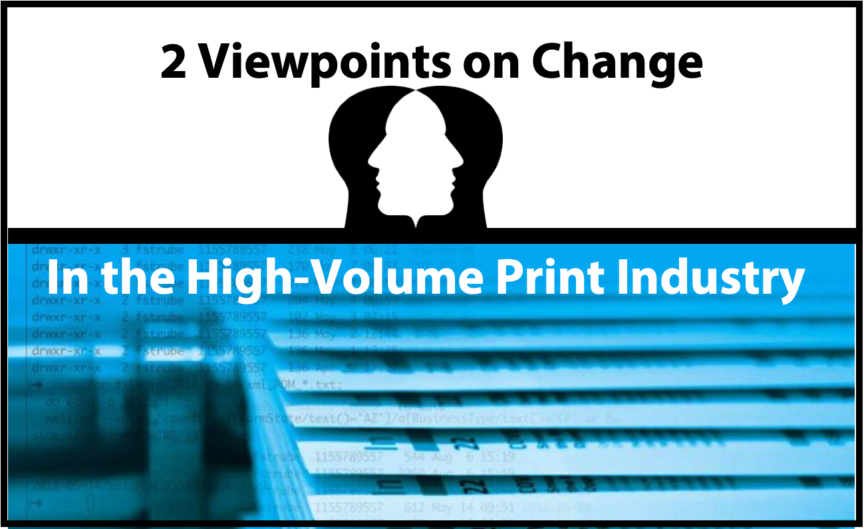Two Perspectives and Revealing Advice on Inkjet Printing
An investment in a high volume inkjet printing press is not made lightly. Know what kind of investor you are before signing that contract.
I recently spoke with two users of high volume inkjet presses about the issues they encountered when migrating from analog or other digital technologies to inkjet. Edmundo Ortiz and Brian Dicker offered very different answers to the same question: What advice do you have for someone considering inkjet printing?
Morevang
Edmundo Ortiz, is the Head of Digital Printing at Morevang, based in Alexandria VA. Morevang describes itself as “first and foremost, a creative place.” Its offering includes analog and digital printing, wide format inkjet printing, packaging and experiential services along with the software and coding to make them happen. Mr. Ortiz has been in the printing industry for nearly 20 years, starting out in small offset printing and then moving to HP Indigo and now Canon inkjet digital printing.
Morevang purchased its sheetfed Canon VarioPrint i300 about a year ago, replacing one of its two HP Indigo printers and a Heidelberg offset press. The printer has exceeded Morevang’s expectations in terms of speed and quality. The question of whether it will produce offset quality is not seen as a question of “if” but “when” that will occur. In the meantime, Mr. Ortiz has been struck by the i300’s versatility, being able to print a wide range of paper sizes without a blanket change and the fact that printing final size work can go straight to shipping or mailing. As he put it, “there is a big difference between reading specs and actually experiencing inkjet printing in action.”
Nevertheless, Mr. Ortiz advises “picking your battles.” For example, while the quality on uncoated papers is up there, he noted that inkjet printing on coated stocks has certain limitations in terms of opacity and color vibrancy. Morevang has begun using Canon’s primer ink so the operator can put more ink down when necessary.
By eliminating preprinted shells and imprinting them, inkjet is proving to be less expensive for Morevang than liquid electrophotography. Mr. Ortiz noted the difference in quality means that Morevang picks its battles by determining their customers’ individual quality requirements and then using the best technology for the application.

Photo source: https://www.morevang.com/content/uploads/2018/08/aacc-banner-1336×516.jpg
Strahm
Brian Dicker is President of Strahm Automation and Mailing Services, a 113 year old company located in Kansas City MO. I first met Mr. Dicker, who purchased Strahm more than 26 years ago, when I was operations manager for Liberty Mutual and outsourced the printing and mailing of flats to Strahm. Specializing in variable digital printing in B/W, highlight and full color, Strahm is a transactional and direct mail company with complete lettershop and MLOCR presort services.
Mr. Dicker is an owner who knows the details of what is happening in the shop. He knows to the “mil” (thousandths of a dollar) the cost of jobs being produced. For him, scheduling is critical because of the cost of paper waste and head cleaning. As he put it, a group of jobs must start “with the heads out,” that is, printing 4/4 and working down to 1/0.
Why? Because the jobs can be sequenced with minimal paper use between jobs and there is no need to use consumables to purge the printheads between jobs. As Mr. Dicker put it, as soon as you change something on the roll-fed Canon ImageStream 3500 it can take 200’ of paper to feed the press. Waste at the beginning of Strahm’s inkjet journey was 20% but is now as low as 6%. And its consumables cost has been lower than the estimates provided by Canon’s costing software. Keep these numbers in mind when developing an ROI for your potential investment in inkjet printing.
This brings up Mr. Dicker’s other advice: Cut sheet is easy to price but inkjet has too many variables, such as the mix of jobs and colors on a given day. Nevertheless, keep your costing simple by avoiding preprinted stocks and limiting blank paper selection to as few as two to three uncoated papers and one coated paper. For example, Strahm has moved most its clients to plain papers (one exception is the customer who requires a very specific shade of red) without an issue.
Insights
Morevang and Strahm are two very different companies with inkjet printing in common. What can anyone considering an investment in high volume inkjet printing learn from them?
- Don’t just estimate what your costs may be, know your true costs. Recognize that the margin will vary with every job because you will price based on the market, yet the cost will be based on the actual order mix on a given day.
Factors will include the customer’s document design, data requirements and run length, the printer’s output resolution, paper range, print speed, waste and spoilage, and your labor costs and overhead.
- Don’t just think you know your potential customer’s needs, test their willingness to actually use inkjet. Work with the technology provider to produce inkjet-printed samples of the customer’s work on the customer’s paper with the customer’s data. And then pick your battles.
Factors will include brand messaging, color profiles and management, personalization and inkjet printing’s intersection with the customer’s multichannel marketing efforts.
As you can tell from these successful companies, inkjet printing is neither as simple nor as complex as it may seem. Let us facilitate an unbiased exploration of the production inkjet printing opportunities and uses that are right for your business.

